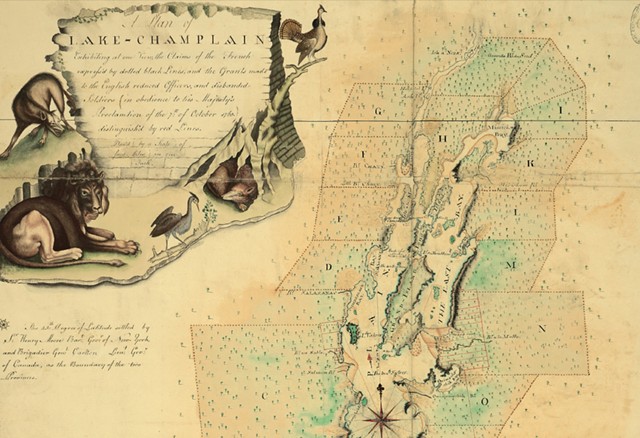
- Courtesy of the National Archives
- Lake Champlain and a cartouche from a 1767 map
Authors Rose Mitchell and Andrew Janes are map archivists at the National Archives in London, a fact that accounts for the book's overall Anglocentric focus. And while it does contain many a map of Britain and her former colonies, this handsome, profusely illustrated volume also offers such fascinating features as a map of 19th-century Edo (now Tokyo), a map of the Allied forces' invasion of Normandy and, from 1836, the first-known pen-and-ink map by an Aboriginal Australian.
One chapter, "New Worlds: Exploration and the Colonies," showcases maps that testify to the massive wingspan of the British Empire. Amongst the maps of Gambian slave forts and the Indian subcontinent is a 1767 map of French and British claims to the forested parcels of land that surrounded Lake Champlain. Created by Yorkshireman Simon Metcalfe, the surveyor general of New York province, the map shows how the two countries' claims conflicted.
Even more interesting is the watchful lion that joins a wolf, a crane and a turkey in the cartouche in the map's upper left corner. Cool your jets, Catamount Truthers: Just as in the present day, no lions romped through the Champlain Valley in the mid-18th century. Rather, as the authors write, the mapmaker included this fearsome beast in order to "convey ... to those in London both the inherent possibilities and the dangers present in the colonies."
Fanciful details such as that incongruous lion are exactly what make this and the other maps in the book so fascinating. The maps' very inaccuracies speak most eloquently to their origins and attest to their historical significance.
Speaking of...
-

Totally Transfixed: A Rare Eclipse on a Bluebird Day Dazzled Crowds in Northern Vermont
Apr 10, 2024 -

Q&A: Catching Up With the Champlain Valley Quilt Guild
Apr 10, 2024 -

Video: The Champlain Valley Quilt Guild Prepares for Its Biennial Quilt Show
Apr 4, 2024 -

Q&A: Digging Into the Remnants of the Ravine That Divided Burlington
Mar 27, 2024 -

Video: Digging Into the Ravine That Divided Burlington in the 1800s
Mar 21, 2024 - More »






Comments
Comments are closed.
From 2014-2020, Seven Days allowed readers to comment on all stories posted on our website. While we've appreciated the suggestions and insights, right now Seven Days is prioritizing our core mission — producing high-quality, responsible local journalism — over moderating online debates between readers.
To criticize, correct or praise our reporting, please send us a letter to the editor or send us a tip. We’ll check it out and report the results.
Online comments may return when we have better tech tools for managing them. Thanks for reading.